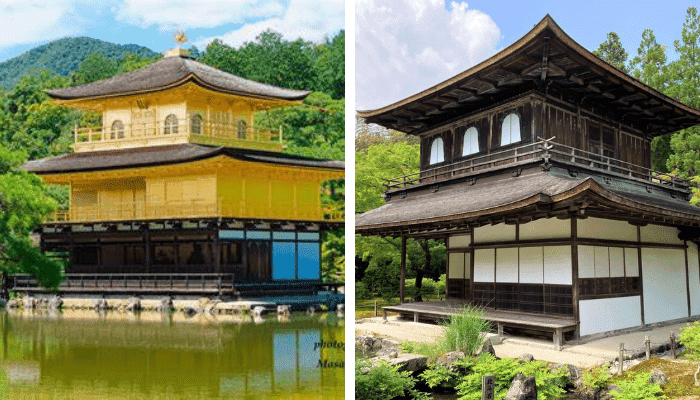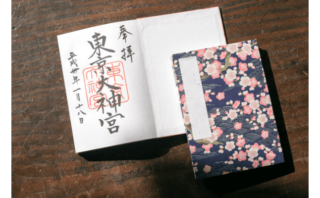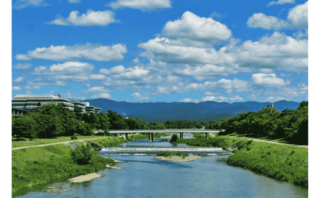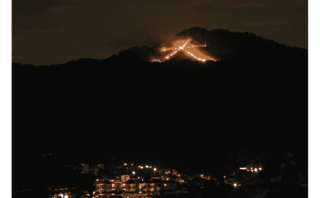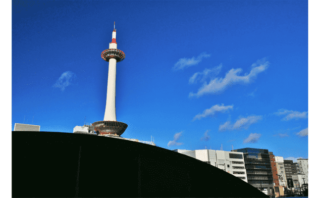Kinkaku-ji and Ginkaku-ji—these names sound catchy and are easy to remember.
Kinkaku-ji, officially known as Rokuon-ji, is world-famous for its golden pavilion (Kinkaku), which is covered in gold leaf and shines brilliantly.
On the other hand, Ginkaku-ji‘s official name is Higashiyama Jisho-ji, and its main hall, called Ginkaku (Silver Pavilion), has an interesting history. Despite its name, it was never actually covered in silver leaf!
It is said that during the Edo period, the pavilion appeared silver under the moonlight, which led to its nickname, Ginkaku-ji. Some rumors suggest that silver leaf was planned but never applied due to budget issues, but historical records indicate that this was never the case. Interestingly, the temple chose not to correct this misconception, as it helped attract visitors.
In this guide, we’ll compare Kinkaku-ji and Ginkaku-ji, highlighting their similarities and differences, as well as providing information on goshuin (temple stamps), admission tickets, and how to get there.
- Comparison of Kinkaku-ji and Ginkaku-ji
- Common Features of Kinkaku-ji and Ginkaku-ji
- Basic Information: Kinkaku-ji and Ginkaku-ji
- Differences Between Kinkaku-ji and Ginkaku-ji
- Admission Ticket with a Lucky Charm Design
- Goshuin (Temple Seals)
- Access: Traveling Between Kinkaku-ji and Ginkaku-ji
- Summary: Which One Do You Prefer?
Comparison of Kinkaku-ji and Ginkaku-ji
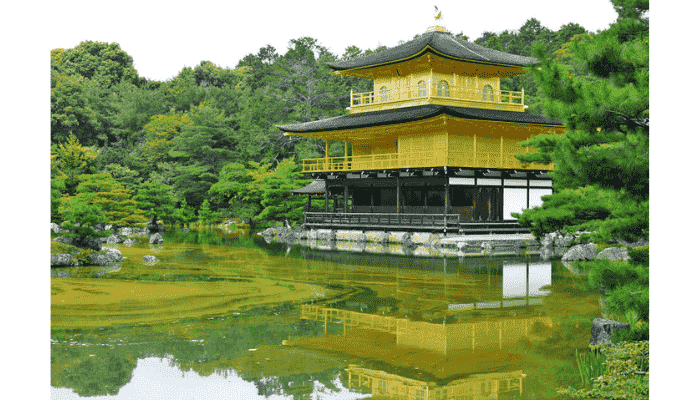
| Kinkaku-ji (Golden Pavilion) | Ginkaku-ji (Silver Pavilion) | |
| Location | 1 Kinkakuji-cho, Kita-ku, Kyoto | 2 Ginkakuji-cho, Sakyo-ku, Kyoto |
| Phone Number | +81-75-461-0013 | +81-75-771-5725 |
| Opening Hours | 9:00 AM – 5:00 PM (Open all year) | – 8:30 AM – 5:00 PM (Dec 1 – End of Feb: 9:00 AM – 4:30 PM) – Open all year |
| Admission Fee | Adults & High School Students: ¥400 Elementary & Middle School Students: ¥300 | Adults & High School Students: ¥500 Elementary & Middle School Students: ¥300 |
※Hours and fees may change during special exhibitions.
Common Features of Kinkaku-ji and Ginkaku-ji

Although Kinkaku-ji and Ginkaku-ji were built in different periods, they share several similarities.
1. Built as Villas for Ashikaga Shoguns
- Kinkaku-ji: Built by Ashikaga Yoshimitsu, the 3rd shogun of the Muromachi Shogunate.
- Ginkaku-ji: Built by Ashikaga Yoshimasa, the 8th shogun of the Muromachi Shogunate.
- Both were originally constructed as villas and later converted into Zen temples according to their founders’ wills.
2. Temple Names Come from Their Founders’ Buddhist Titles
- Kinkaku-ji: Officially named Rokuon-ji, derived from Yoshimitsu’s Buddhist title, Rokuon-in.
- Ginkaku-ji: Officially named Jisho-ji, derived from Yoshimasa’s Buddhist title, Jisho-in.
3. Founded Under the Guidance of Zen Master Muso Soseki
Muso Soseki (1275–1351) was a Rinzai Zen monk who played a key role in spreading Zen Buddhism. He was a spiritual advisor to the first Muromachi shogun, Ashikaga Takauji, and also famous for designing beautiful Zen gardens.
4. Sub-temples of Shokoku-ji Temple
- Shokoku-ji is the second-ranked temple among Kyoto’s “Five Great Zen Temples” (Kyoto Gozan).
- It was founded in 1392 by Ashikaga Yoshimitsu under an imperial order from Emperor Go-Komatsu.
- Muso Soseki was its founding abbot.
- Kinkaku-ji and Ginkaku-ji are sub-temples (tatchu) of Shokoku-ji. (Tatchu are smaller temples built in honor of Zen masters after their passing.)
5. Scenic Strolling Gardens with Ponds
- Kinkaku-ji: Features a beautiful stroll garden centered around Kyoko-chi (Mirror Pond).
- Ginkaku-ji: Its garden is centered around Kinkyo-chi (Brocade Mirror Pond).
Both temples are renowned for their stunning landscapes and deep connections to Zen aesthetics.
Basic Information: Kinkaku-ji and Ginkaku-ji
| Category | Kinkaku-ji (Golden Pavilion) | Ginkaku-ji (Silver Pavilion) |
|---|---|---|
| Official Name | Rokuon-ji | Higashiyama Jisho-ji |
| Year of Establishment | 1420 (Ōei 27) | 1490 (Entoku 2) |
| Founder | Ashikaga Yoshimitsu (3rd Shogun of the Muromachi Shogunate, 1358–1408) | Ashikaga Yoshimasa (8th Shogun of the Muromachi Shogunate, 1436–1490) |
| Inaugural Head Priest (Kanjō Kaizan) | Muso Soseki | Muso Soseki |
| Cultural Style | Kitayama Culture (refined aristocratic culture of the Muromachi period) | Higashiyama Culture (aesthetic culture emphasizing simplicity and Zen influence) |
Glossary (Zen Buddhism Terms)
- Founder (Kaiki) – The person who established a temple or provided financial/political support for its construction.
- First Abbot (Kaizan) – The first head monk of a temple.
- Inaugural Head Priest (Kanjō Kaizan) – When a temple is built, sometimes the founder appoints a respected Zen master as the first abbot rather than serving in the role themselves.
Differences Between Kinkaku-ji and Ginkaku-ji
Kinkaku-ji (Golden Pavilion) and Ginkaku-ji (Silver Pavilion) are not just visually different—their purposes as villas were also quite contrasting.
Kinkaku-ji: A Symbol of Power and Diplomacy

Built by Ashikaga Yoshimitsu, the 3rd shogun of the Muromachi Shogunate (1358–1408). Yoshimitsu unified the Northern and Southern Courts and established strong shogunate rule, leading the Muromachi period to its political, economic, and cultural peak.
The name “Muromachi Shogunate” comes from his official residence, Muromachi-dono, also known as Hana no Gosho (Blossoming Palace).
After ensuring political stability, Yoshimitsu sought personal freedom. In 1394, he abdicated in favor of his 9-year-old son, Yoshimochi, and became a Buddhist monk the following year. However, he continued to hold real power.

In 1397, he built a luxurious villa called Kitayama-dono (North Mountain Palace) in northern Kyoto, which later became Rokuon-ji (Kinkaku-ji). The dazzling Golden Pavilion (Shariden) was designed to reflect his authority and admiration for the imperial court.
At its peak, Kitayama-dono was as grand as the imperial palace, and in 1399, Yoshimitsu fully relocated there, concentrating all political power in the villa. He even hosted envoys from China’s Ming dynasty at Kitayama-dono, promoting trade and introducing Chinese cultural influences that shaped the Kitayama Culture.
In 1408, Yoshimitsu held a grand banquet for Emperor Go-Komatsu, known as the Kitayama Imperial Visit, a symbol of his power and status.
Ginkaku-ji: A Retreat for Arts and Culture

Built by Ashikaga Yoshimasa, the 8th shogun of the Muromachi Shogunate (1436–1490).Unlike Yoshimitsu, Yoshimasa struggled to control the government due to interference from his wife’s family (the Hino clan), close advisors, and powerful feudal lords.
In 1467, a succession dispute triggered the Onin War, a devastating conflict that lasted for 11 years (1467–1477), leaving Kyoto in ruins.

Disinterested in politics, Yoshimasa abdicated in 1473, handing power to his 9-year-old son, Yoshihisa. After the war ended, in 1482, he began building Higashiyama-dono (Eastern Mountain Palace) in eastern Kyoto, later becoming Jisho-ji (Ginkaku-ji).
Yoshimasa moved in the following year, dedicating himself to his interests—architecture, gardens, and the arts. He invited Zen monks, nobles, samurai, and talented individuals from all social classes to cultivate tea ceremony, ink painting, and poetry, fostering the refined and elegant Higashiyama Culture.
Many aspects of Higashiyama Culture continue to influence Japanese aesthetics today, including wabi-sabi, tea ceremony, and garden design.
Admission Ticket with a Lucky Charm Design
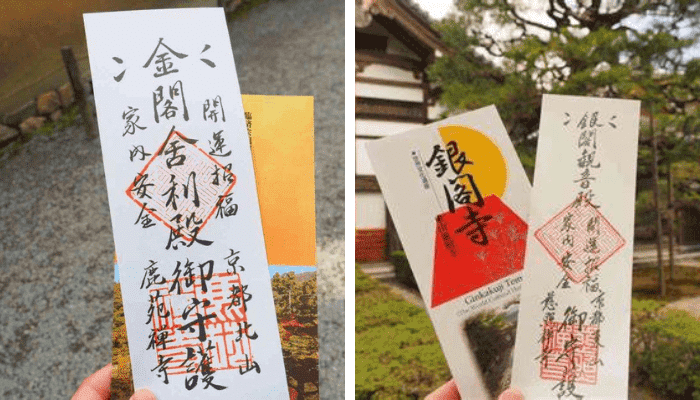
The general admission ticket at both temples is designed to look like a ofuda (a traditional Japanese lucky charm) and features blessings for good fortune and household safety.
You can keep it as a souvenir, display it on a wall like a real ofuda, or even dispose of it as regular paper. However, if you feel uncomfortable throwing it away, you can return it to the ofuda collection box within the temple grounds.
Goshuin (Temple Seals)
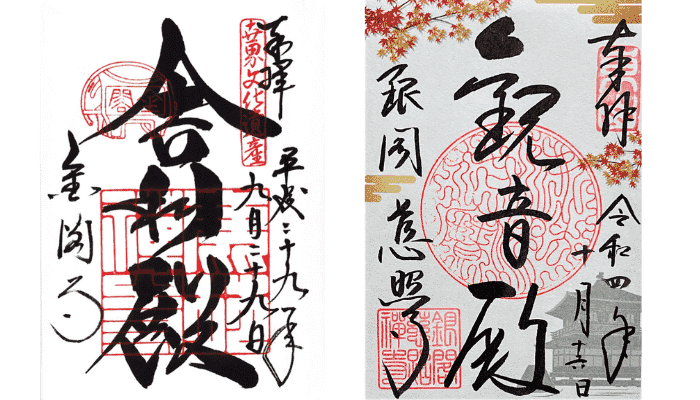
Kinkaku-ji (Golden Pavilion) – Left Side: “Shariden” Seal
At Kinkaku-ji, the goshuin booth is located near the end of the temple route. If it’s busy, you may need to wait in line. The fee is 300 yen.
Since the booth is right in front of the amulet shop, you might find yourself tempted to buy an omamori while waiting! There are also plenty of souvenir shops nearby.
Ginkaku-ji (Silver Pavilion) – Right Side: “Kannon-den” Seal
At Ginkaku-ji, the staff at the entrance will ask if you would like a goshuin. If you do, you’ll need to stop by the goshuin booth near the entrance, pay 300 yen, and leave your goshuin book there. You’ll receive a number tag and can pick up your book on your way out.
Since the booth is right by the exit, you won’t forget to collect it!
Access: Traveling Between Kinkaku-ji and Ginkaku-ji
The travel time between Kinkaku-ji (Golden Pavilion) and Ginkaku-ji (Silver Pavilion) varies depending on the mode of transportation:
- By bus: About 1 hour, including waiting time
- By taxi: About 30 minutes
From Kinkaku-ji to Ginkaku-ji
- Walk about 8 minutes from Kinkaku-ji to the Kinkakuji-michi Bus Stop.
- Take one of the following buses:
- City Bus 204 → Arrives at Ginkakuji-michi Bus Stop in about 36 minutes, followed by a 12-minute walk (Total: about 56 minutes).
- Raku Bus 102 → Arrives at Ginkakuji-michi Bus Stop in about 26 minutes, followed by a 12-minute walk (Total: about 46 minutes).
- By taxi: About 22 minutes (Distance: 6.5 km).
Note: Travel times and fares may vary depending on traffic conditions.
From Ginkaku-ji to Kinkaku-ji
- Walk about 12 minutes from Ginkaku-ji to the Ginkakuji-michi Bus Stop.
- Take one of the following buses:
- City Bus 204 → Arrives at Kinkakuji-michi Bus Stop in 37–39 minutes, followed by a 12-minute walk (Total: about 57–59 minutes).
- Raku Bus 102 → Arrives at Kinkakuji-michi Bus Stop in about 26 minutes, followed by a 12-minute walk (Total: about 46 minutes).
- By taxi: About 22 minutes (Distance: 6.8 km).
Note: Travel times and fares may vary depending on traffic conditions.
Summary: Which One Do You Prefer?
Both Kinkaku-ji and Ginkaku-ji are UNESCO World Heritage Sites and attract visitors from all over the world.
Kinkaku-ji, with its dazzling golden exterior, leaves a strong impression, making it a popular spot for photos—so expect crowds around the pond!
Ginkaku-ji, on the other hand, has a more understated, elegant charm, offering a peaceful and refined atmosphere.
Both temples are surrounded by stunning gardens that make use of the natural landscape.
So, which one do you prefer?
▼ Related Articles for Kyoto Sightseeing
